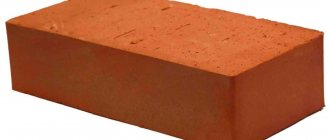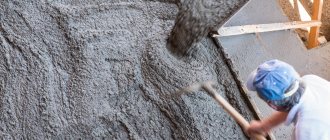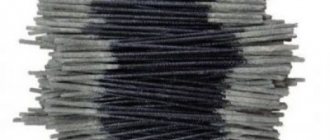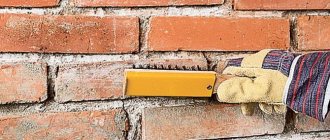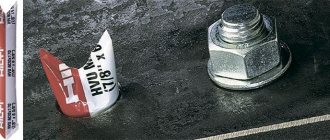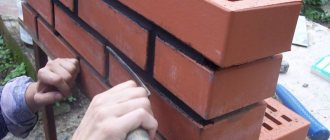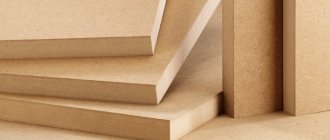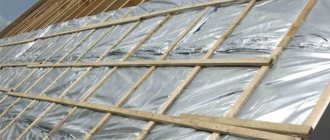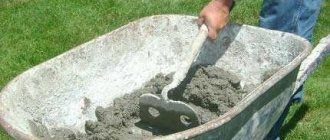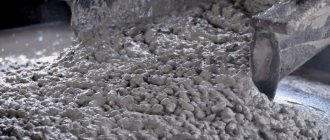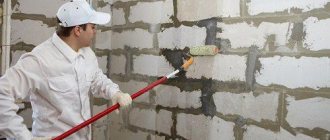Types of dressing of brick masonry
The main requirements for brickwork are stability and strength. This can be achieved by bandaging the seams so that each brick rests on two or three bricks from the bottom row of masonry, overlapping the seams between them. This method of building a wall allows you to achieve not only stability, but also to evenly distribute the load on each brick of the masonry. This is important, given the unevenness of precipitation and temperature deformations to which the brick wall is exposed. Depending on the location of the bricks, the rows of masonry are divided into spoon rows (elements are laid along the wall line) and bond rows (perpendicular to the wall). The most common types of dressings are:
- Single row chain . Spoon and butt rows alternate. It is used if decorative brick finishing is not provided.
- Three-row . Every three spoon rows are tied with tie rows. Used when you need to lay out partition walls and posts.
- Multi-row . Spoon rows are tied with tie rows every 5–6. The quantity depends on the thickness of the brick used.
Tolerances and average values
It is impossible to ensure perfect compliance with all possible proportions. There are tolerance values within which a seam is considered normal. This indicator is determined individually for each project, indicating the permissible deviation in seam thickness for various masonry options. Average values have also been developed that can be used as a guide when drawing up a project. The average deviation of the horizontal seam is 10-15mm. The same indicator for vertical seams is 8-15mm.
Question about framed inflatable curtain
The water remains near the surface, where it gradually evaporates.
The cream is introduced into the masonry with drilled holes with a diameter of 13 to 20 mm. The holes are usually thrown horizontally into some of the spacers in the brickwork. Application to the wells is carried out under a pressure of no more than 2 bar using a low pressure sprayer with an extension nozzle without a nozzle and filter. Depending on the diameter of the holes, 2-3 times more filling. It was born from mechanical methods of horizontal moisture insulation, which in richness lead to masonry and its degradation, curtains with infinite aperture are preferred. In practice, the thickness of the seam is determined based on many factors, for example, the time of year and weather conditions in which the masonry is carried out. When laying bricks at sub-zero temperatures, it is especially important to comply with the requirements of building standards regulating this indicator. If the joint is too wide, the water in the solution may freeze before it “sets.”
The key issue is how potent the active ingredient will be and whether it will result in practical success or be non-hazardous to masonry work. The specification of these artifacts is not the purpose of this article; so let's just give a quick overview.
Working with a trowel
Highly alkaline products based on water glass are not suitable for inspection because they lead to corrosion of the iron compounds contained in the rich ones. In addition, a large amount of water is soaked into the masonry, causing a sudden change in the humidity regime and subsequent decomposition of the eyepiece.
Subsequently, as the temperature rises, the ice in the solution will turn back into water. In this case, the solution will lose strength. It is for this reason that when laying bricks in cold weather, the width of the seam is minimized to the limit. In some cases it can reach 5mm or less. To eliminate the risk of freezing of water in the solution during winter construction, various additives are used that act as antifreeze. If complex masonry is made from fire-resistant materials, the thickness of the seam is also kept to a minimum.
Additionally, mud brickwork is often a term for a squall that can be filled with large amounts of water. Another obstacle is the chemical neutrality of natural stone. As we know, silicone needs a widespread environment for it to react and reacts very slowly to natural stone and yen masonry.
Properties of the cream curtain for cream from a luxury point of view
When oil is injected into a masonry well, the oil is broken down into the silane-siloxane active material and water. The active ingredient gradually penetrates into the surrounding circles in the masonry around the wellbore, and the released water, which is even small, remains in the wellbore and near the wellbore, from where it gradually evaporates in space.
Why do you need jointing of brickwork?
Brickwork has horizontal and vertical joints. The cement mixture with which they are filled holds the wall together as a single unit. During the construction process, excess mixture is removed after dressing. After this, they begin to unstitch the seam.
The process is grouting to improve the tightness. If decorative finishing is used, jointing can be omitted. Thanks to this procedure, the brickwork gets an attractive appearance and resistance to adverse factors. You can embroider both a freshly erected brick wall and a structure of considerable age. The technologies in both cases are practically the same.
Seam dressing system for brick houses: varieties
The basic principle of this action is to limit the vertical lines of cement, which cannot bear strong loads and will easily lead to the destruction of the wall. In fact, the bricks of the upper row of vertical seams of the lower one overlap. In this case, the minimum size of the covering brick is a quarter of the surface in any of the planes. Today, there are several main dressing systems, each of which has its own advantages and disadvantages.
Single row
It involves laying each row of bricks in a different direction, which is determined by the side of the product facing the front of the facade. With a single-row dressing, the very first row is laid with butts, that is, the products are placed perpendicular to the wall line. The next row is laid in spoons - along the line of the facade with the long narrow side. In this case, the vertical seams of the top row of bricks run almost in the middle of those laid below. The third row is laid again with pokes, the fourth with spoons, and so on. This dressing of brickwork seams is the most reliable and durable. But, at the same time, it requires serious labor costs and consumption of building materials.
Multi-row
The principle is similar to the previous one, only with a slight clarification - the first and sixth rows are laid in the poke, and all the other intermediate five are arranged using the spoon method. In this case, the ligation of these rows occurs according to the simplest scheme - an overlap of half a brick along the length. This method is much more economical in terms of construction speed and consumption of building materials, but cannot provide too high a level of reliability. Multi-row dressing is used in the construction of almost all country cottages with a height of 2-2.5 floors. During installation, the longitudinal seams are not completely ligated, so this method is only suitable for walls. The columns are arranged using the first dressing method.
Other types
In the practice of building cottages of varying levels of complexity, there are several other methods of bandaging the seams of brickwork. They differ in the brick laying pattern and even in the use of smaller details, such as the material split along the length. They all adhere to the principle of breaking any direction of the cement joint to increase the strength of the structure. In addition, they have an unusual and attractive appearance:
- Dutch and Flemish, distinguished by alternating spoon and poke;
- English with a peculiar pattern;
- Gothic with an original way of laying bricks.
The choice of the appropriate method depends on the preferences of the customer and the style solution in the exterior of the cottage. If the wall itself will serve as a finished part of the facade, then it makes sense to choose a more original method of laying bricks. If further finishing follows, then it is better to prefer simpler options with a minimum of decoration.
Types of jointing of brickwork
This decorative finish has several options. In construction practice, the following types of seams are most often used:
- Rectangular undercut (“flush”). Excess cement mixture is cut off from the wall using a “trowel” construction tool, after which the seam is treated with a hard-bristled brush. This method is the simplest and most popular.
- Rectangular recessed . It is used as one of the decorative finishing options. The cement mixture is removed from the seam to a depth of 5 mm. The remainder is smoothed out using a tool called a dowel. This method is more labor-intensive, however, the jointing looks more aesthetically pleasing.
- Concave . This is done using a tool called “jointing”. The excess cement mixture is cut off with a trowel, then the seam is processed along its entire length.
- Beveled . One of the methods that is relevant for areas with harsh climates. The mixture is removed from the seam using a sharp trowel pointed at an angle. A recess of up to 4 mm is considered optimal.
When performing jointing, it is important to follow the sequence of actions: first, vertical seams are processed, then horizontal ones. Experts believe that the thickness of the seam is not fundamental and can vary between 10–12 mm. According to SNiP, the thickness of the joint in a brick wall is a variable indicator, depending on the climatic conditions of the area where the building is located. To save cement mixture, if it is difficult to buy additional cement at an adequate price, specialists can use joints up to 4 mm thick.
What should be the thickness of the brickwork joint?
Obviously, it is almost impossible to achieve ideal and absolutely uniform thickness of seams, so there are some tolerances within which the seam thickness is considered normal. In any serious construction project, the average thickness of joints for different types of masonry must be indicated. However, there are also average indicators. For horizontal seams
this is
10-15mm
, for
vertical ones - 8-15mm
.
However, there are many factors that further influence the choice of seam thickness. For example, when they try to achieve the minimum possible thickness. And in some cases, the thickness of the seams can even be 5 millimeters or less. As a rule, this thickness of joints is typical for critical masonry used in high-temperature furnaces.
Is there any point in doing jointing?
When hiring a construction team to erect a brick building, the price of the work will be lower if you avoid jointing. Many brick buildings can be used for a long time, without embroidered seams. Maybe technology is not as necessary as is commonly believed?
As noted above, the aesthetic qualities of the wall are significantly improved when jointing is carried out. Using this method, you can mask the difference in shades of the solutionif mixing was carried out at different times over several days. Grouting helps prevent the destruction of the cement base, which extends the life of the building and postpones the need for major repairs. This effect is achieved by reducing the amount of moisture entering the seam, which causes the destruction of the masonry. The cost of restoring a brick wall, which has undergone changes in the structure of the cement mixture, is impressive enough to once again play it safe.
Step-by-step guide to unstitching
Having a theoretical basis regarding the need for jointing, you can begin finishing work. The procedure is carried out in several stages.
Preparation
All dust and dirt are removed from the wall surface. Cement joints are cleaned of the most “coarse” lumps using a hard-bristled brush. Sometimes a device for removing contaminants under high pressure. This device is expensive to purchase, but it can be rented. It is with its help that it is possible to remove the smallest particles of the solution that are invisible to the eye.
Using a wet roller, the seams are wetted, the treatment of which is planned first. Experts do not recommend jointing in the summer, as the solution dries quickly, which disrupts the process technology. Work should not be carried out during rain, as the solution will absorb too much moisture.
Preparation of the solution
The jointing composition is sold in the form of a dry mixture or a ready-made solution. The dry mixture is diluted with water, the required amount of which is indicated on the package. Regardless of the type of mixture, you should follow the instructions for use and observe the proportions. Also take into account the time during which the composition should be completely used.
For mixing, it is better to use an electric drill with a mixing attachment, since manual mixing is time-consuming. Do not immediately mix the amount of solution required to treat the entire wall. If you apply a mixture that is too wet or has already dried out, this can lead to the destruction of the seam due to temperature changes.
Joining
First of all, remove the old mortar to a depth of 15 mm. Use a stiff bristle brush to remove all traces of mortar from the wall. In hard-to-reach places, you can use a chisel. To process the top of the wall, you can use a stepladder or install scaffolding.
The key to the success of the procedure is the uniformity of the applied mixture and the absence of lumps. The solution should be applied in excess, immediately removing the excess with a trowel. Next, using a narrow joint, press the mixture into the vertical seams. Treat horizontal seams using long jointing. It is important to press the solution and not smooth it, as this allows you to remove excess air from the seam.
The concave seam can be given the desired shape using available means, for example, a rubber hose or a plastic tube. To obtain a beveled seam, you can use a wooden strip, and for a recessed seam, a wooden peg is suitable. As you can see, the process is quite simple and is not difficult even if you have no construction experience. Of course, a beginner will spend more time on work than a professional, but this allows you to save money by refusing the services of specialists and doing everything yourself.
Factors determining seam dimensions
The consistency of the masonry mortar is such that it allows, when pressure is created on it, to fill surface unevenness, but only if the layer of the mixture does not exceed a certain thickness. If the condition is violated, the mass simply spreads to the sides without filling the roughness, which deteriorates the quality of the seam. From this point of view, the optimal value for a horizontal seam in brickwork is 10-15 mm. Vertical ones can be maintained at a slightly smaller interval, on average 10 mm.
The general average value of the thickness of the mortar layer is calculated by measuring each layer within the height of the masonry, the recommended figure is 12 mm. This applies to single (65 high) and one-and-a-half (88) bricks; they are used when developing a construction project. If the ceramite is double (138), then the seam should increase to 15 mm. To work by eye, plastic inserts are used - templates between masonry elements like crosses when gluing tiles.
Non-standard elements and the influence of inclusions in the mortar layer
Separately, it is necessary to consider construction from other building materials, which are significantly larger in size than brick. These are the following products:
- Gas blocks and foam blocks. Using masonry mortar, only the first row is installed. The thickness of the seam is determined by the unevenness of the base; the layer itself plays a leveling role. Further laying is done on an adhesive base, which has practically no thickness.
- When using reinforced concrete elements, the solution should not be thick. Usually milk of lime is mixed into it. The thickness of the seam is also not standardized here; the unevenness is simply smoothed out.
- In masonry it is impossible to develop any standard that is close to reality, since the places where the blocks meet do not have smooth edges, but are represented only by irregularities. Moreover, often strictly vertical seams are absent, and inclined ones are replaced. But filling the distances between the stones with mortar must be complete, usually the size of the cracks is 30-40 mm.
Sometimes a reinforcing mesh is used during masonry, but its thickness is insignificant and does not affect the standard size of the seam. In winter, to warm up the brickwork, heating electrodes are placed between the ceramites, but even under such conditions, the distance between the planes should be maintained within 12 mm.
